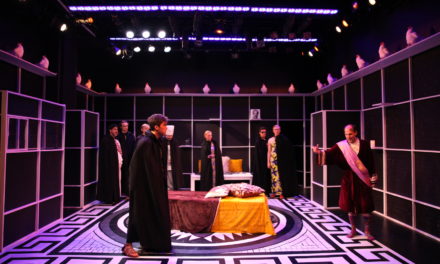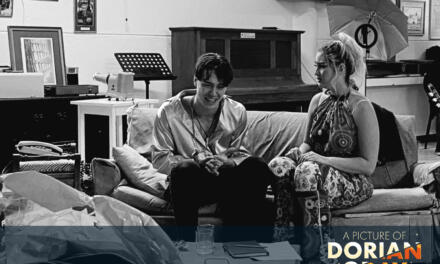The Glass Menagerie is a masterpiece work of Tennessee Williams, it is a jewel of world dramaturgy, which reflects realism as an aesthetic category, one of the most difficult styles due to its dramatic potential.
It is a play that proposes a renovation in the theatrical codes of the mid-twentieth century, highlighting the break in the unit space/time/action and relates the high poetic level of the story that shows the emotional fragility of human beings.
It exposes silent and isolated fantasies, through the relationship of a mother and her two children. Each of these characters seeks in an everyday effort the meaning of their own lives.
 Diego del Río’s production has an enormous artistic value because it articulates with intelligence and dynamism a fully achieved stage language that reflects sensitivity and talent. We can see an excellent performance of Blanca Guerra who is one of the best actresses in the role of Amanda Wingfield, Pedro de Tavira Egurrola who plays Tom Wingfield and shows his talent since he steps on stage, Adriana Llabrés embodies the character of Laura, and Mariano Palacios and David Gaitan alternate the role of Jim.
Diego del Río’s production has an enormous artistic value because it articulates with intelligence and dynamism a fully achieved stage language that reflects sensitivity and talent. We can see an excellent performance of Blanca Guerra who is one of the best actresses in the role of Amanda Wingfield, Pedro de Tavira Egurrola who plays Tom Wingfield and shows his talent since he steps on stage, Adriana Llabrés embodies the character of Laura, and Mariano Palacios and David Gaitan alternate the role of Jim.
Amanda is a southern woman who leaves the idyllic world of Blue Mountain to settle in a sordid apartment in St. Louis that is entered down by the fire escape. She only returns to Blue Mountain through her memories. She is a dominant and castrating mother, showing a curious mixture of idealism and practicality. She feels with the power to manage, dispose, and control the lives of others in a neurotic and obsessive way.
The Glass Menagerie presents a well-known equation: the family microcosm that refers us to the human essence through the portrait of a North American family of the 30s during the Great Depression, showing us a cross-section in the social flow that reflects the mechanics of which evolves a collective destiny and how the complex social force influences.
This work shows the history of the Wingfield family, a family of the United States of the last century, which is formed by Amanda (the mother), Tom (the son), Laura (the daughter), and the portrait of a father who left them leaving them to their fate; another character is Jim, Tom’s co-worker, and Laura’s former classmate. With the arrival of the fourth character, this family will try to secure the future of an unrealizable dream.
The plot begins when Amanda realizes that her daughter Laura has left the typing classes due to her shyness due to a physical defect: a slight limp that has transformed her into a pathologically insecure and fragile human being. She lives submerged in an ideal world playing with a collection of glass animal figurines, of her crystal zoo being a unicorn her favorite one.
She spends her time taking care of this collection and listening to his father’s old records. Amanda is thrilled that her daughter finally will have a “gentleman caller” courting her. So, he asks his son Tom to invite a co-worker to dinner. And so, Jim arrives at the Wingfield´s house as a hope, like a breath of fresh air, it is the burning nail to which the mother tries to hold herself to ensure the future of her daughter. But after the dinner, it will be seen that the result of the effort has been unsuccessful since Jim confesses that he is going to get married. Laura finishes the reunion with a broken unicorn, without the horn, now an ordinary horse and all the pieces are turned into crystal figurines about to break.
Tom, works in a shoe store, in his free time he writes poems in shoe boxes and loves to go to the movies. He is the one who supports the family, he dreams a world full of adventures which he wants to escape like his father did. Finally, he abandons his mother and his sister to start his own life.
The image of the absent father stands out at key moments. The story is told from the perspective of Tom, who opens and closes with two shocking monologues that are an autobiographical reflection of the author, in which he shows us the portrait of his dominant mother, his oversensitive sister, and himself.
The play represents the whole family because although Laura, is the owner of this collection, each of them is the crystallization of a certain position before life, each living in his own world in which others have no place. The only thing they have in common is that none of them lives in the present. Amanda lives in the past, Tom in a hazy future, and Laura is oblivious to any sense of time, neither present, nor past, nor future.
The cast fulfills a great performance, showing different states and emotions that reflect their feelings through the music of Iker Madrid.
Jorge Ballina’s stage design makes a proposal that goes out of realism to become a symbolic play that shows the fractures of the characters with life and consists of a huge polygon that occupies the entire stage and reproduces the room and the dining room, arranged in an inclined manner, resembling a Cubist painting of a distorted house as well as the minds of the characters.
The lighting design is by Víctor Zapatero and goes according to the psyche of the characters, lost in a crystal world, Jerildy Bosch supported the design of costumes.
This magnificent play is performing in Mexico City at the Helénico Theater under the production of Óscar Uriel, Rodrigo Trujillo, and Jacobo Nazar and Diego Flores as the executive producer.
The Glass Menagerie
In theater: premiered on Broadway on March 31, 1945, with Laurette Taylor, Julie Haydon, Eddie Dowling, and Anthony Ross at the Playhouse Theater, staying in theaters during 563 performances. In A, rgentina in 1947 with Margarita Xirgú and Esteban Serrador. In 1965 and 1975 with Maureen Stapleton and Piper Laurie, in 1983 with Jessica Tandy and Amanda Plummer, in 1995 with Julie Harris and Calista Flockhart, in 2005 with Jessica Lange and Sarah Paulson and in 2013 with Celia Keenan-Bolger and Cherry Jones and in 2017 by Sally Field and Joe Mantello.
In the movie: It was taken to the big screen in 1950 by Irving Rapper with Gertrude Lawrence, Jane Wyman, and Kirk Douglas. In 1973 a television adaptation was started by Katharine Hepburn and Sam Waterston. In 1987, it was directed by Paul Newman, Joanne Woodward, John Malkovich, Karen Allen, and James Naughton.
Playwright
Thomas Lanier Williams, better known as Tennessee Williams, one of the most prominent dramatists of the twentieth century. He won the Pulitzer Prize for A Streetcar Named Desire (1948) and for The Cat On The Hot Zinc Roof (1955), a Tony Award for best work for The Tattooed Rose (1951) and the award for the Theatrical Critic of New York for The Glass Menagerie (1945) and The Night of the Iguana (1961), among other awards. More than 20 of his plays have been performed on Broadway and in several countries around the world.
This post was written by the author in their personal capacity.The opinions expressed in this article are the author’s own and do not reflect the view of The Theatre Times, their staff or collaborators.
This post was written by Lorena Meeser.
The views expressed here belong to the author and do not necessarily reflect our views and opinions.


















